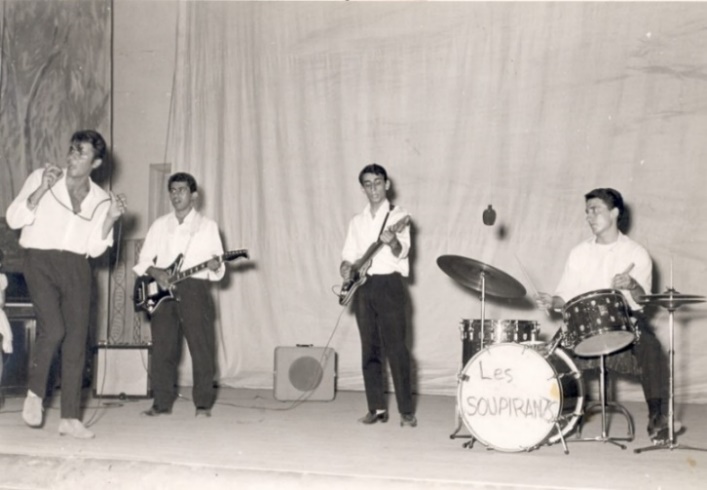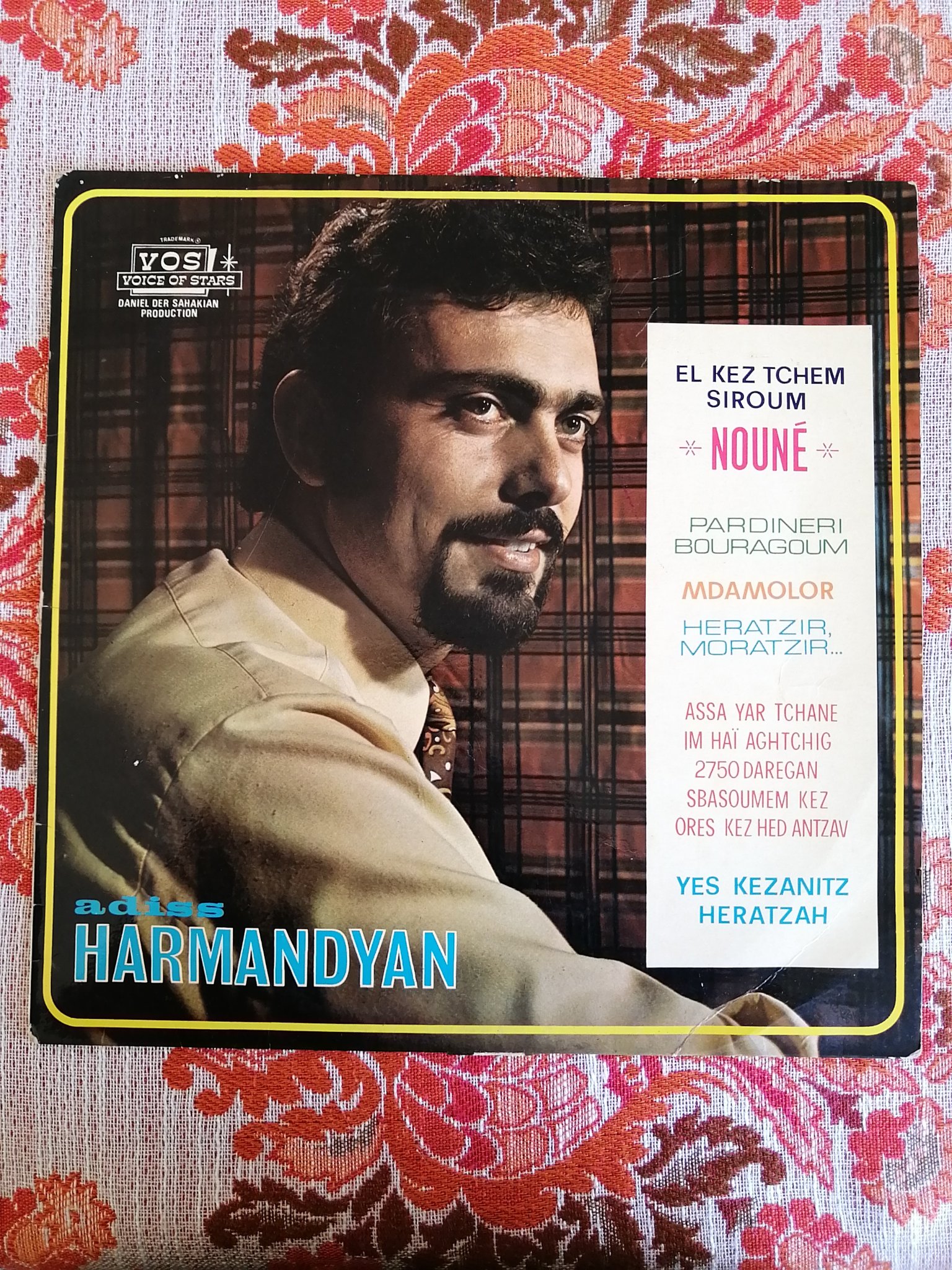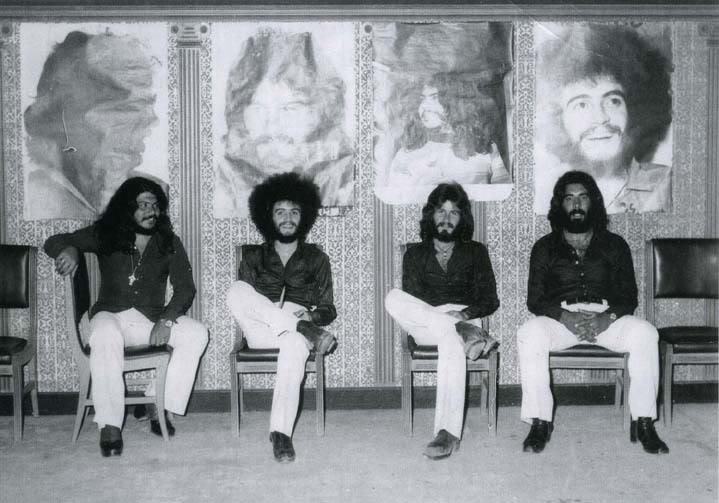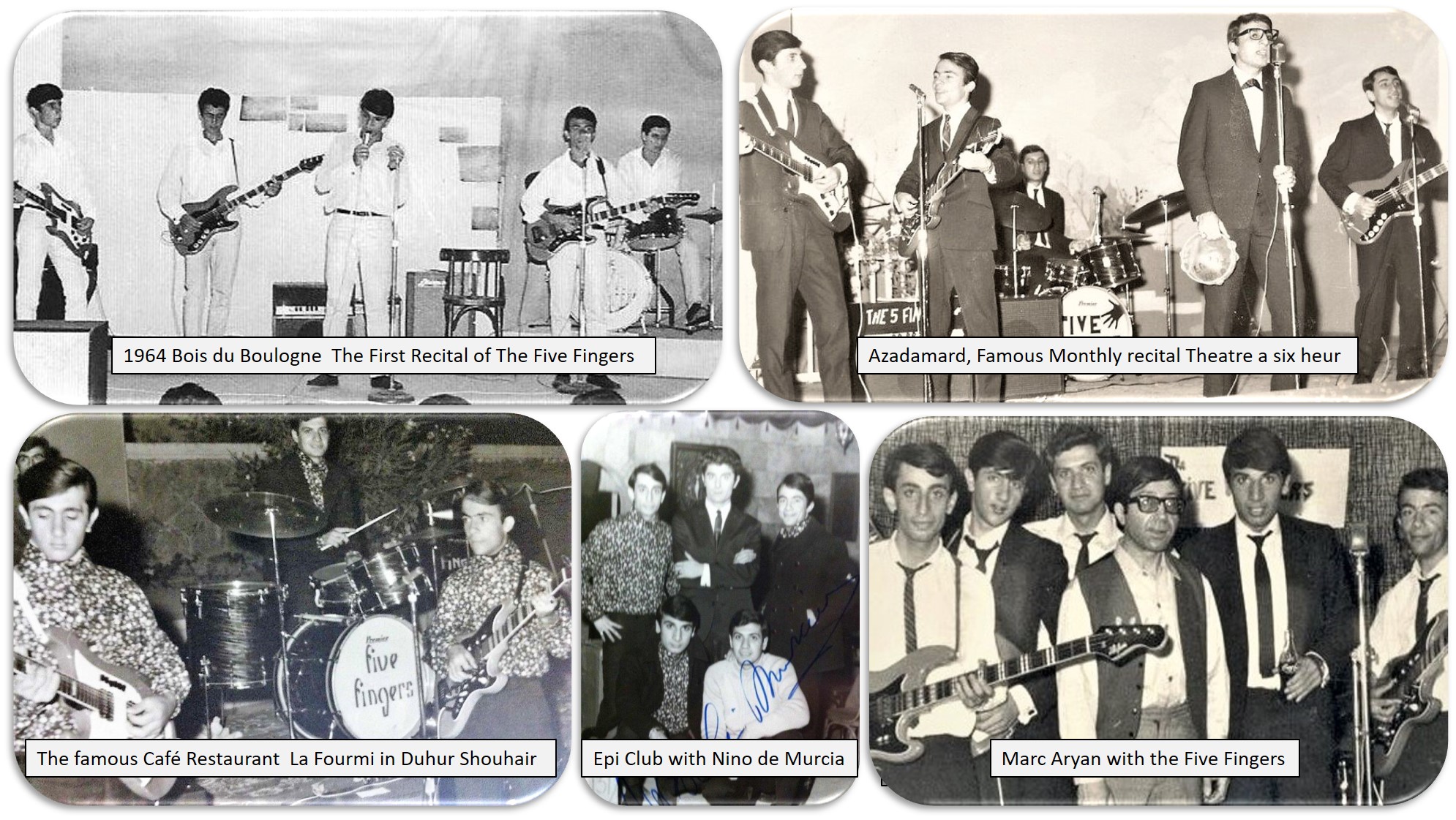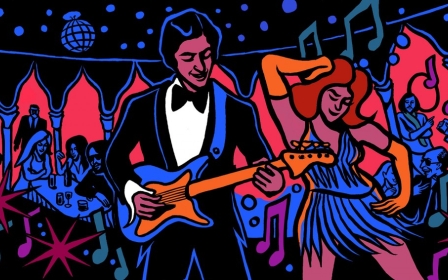The Armenian musicians who established Lebanon’s diverse diaspora scene
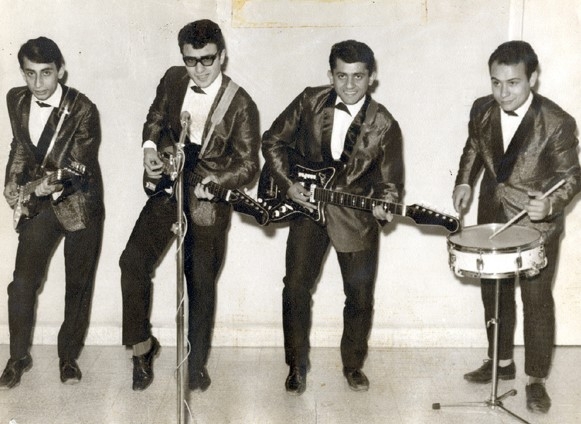
Bourj Hammoud, a northern suburb of Beirut, is the cultural heart of Lebanon’s Armenian community and it’s from there that a vibrant music scene emerged in the 1960s and 1970s.
Following the Armenian genocide of 1915, tens of thousands of Armenian refugees from Cilicia and Western Armenia, arrived by land and by sea to Beirut Port in the early 1920s. They were housed in refugee camps in the Quarantina district, and later, in the early 1930s, relocated to nearby agricultural marshlands on the eastern banks of the river, which was purchased and donated to the community by Armenian organisations.
Turkey still denies that the mass killings and deportations of Armenians was genocide; but some 30 countries around the world, including France, Germany, Russia, Poland and the Netherlands, recognise the Armenian genocide.
New MEE newsletter: Jerusalem Dispatch
Sign up to get the latest insights and analysis on Israel-Palestine, alongside Turkey Unpacked and other MEE newsletters
What started out as a camp, with temporary wooden shacks, developed into the dynamic neighbourhood of Bourj Hammoud, with its narrow winding streets taking the names of its resident’s former villages like Marash and Sis.
The district became a cultural hub full of Armenian schools, churches, and social clubs, radio stations, theatre associations, tens of cinemas, and Lebanon’s first record store. It was also home to the majority of the country’s Armenian musicians.
The music scene of Lebanon’s Armenian community was diverse, varying from Armenian folklore to belly dance and the latest international trends.
These Armenian musicians, composers, record label owners, and producers were the children and grandchildren of genocide survivors and they played a pivotal role in forming the country's rich and multi-layered 1960s and 1970s music scene.
One of the first Armenian diaspora musicians to sing pop music was Mathild Boudakian, who was born in Istanbul in 1917 and emigrated with her family to Lebanon in the mid-1920s, where she became a singer with a weekly music show on Radio Lebanon for over 20 years.
Later, in the mid-1960s, numerous Armenian guitar bands emerged in Beirut. They took Western names like Eddy Kev and The Kings, The Dark Eyes, The Helliums, The Magic Fingers, and the Tears.
The bands sang in French and English and performed the latest styles: twist, beat, pop, and rock and roll. They performed in social clubs, at school dances, and in the theatres, nightclubs, and restaurants of Bourj Hammoud and across Lebanon.
Out of this scene a new, modern style of Armenian-language pop music emerged. It was played with modern instruments and found overnight success in Bourj Hammoud.
Known as "estraydin", the genre was pushed forward by Armenian-Lebanese singer Adiss Harmandian and contributed to the formation of a new cultural identity for the Armenian diaspora, distinct from both Ottoman influences and Soviet Armenia.
Suddenly, scores of Armenian artists started singing in their own language, dropping the westernised aliases of their names and reviving folklore melodies to create innovative pop music, which was released on small independent Armenian labels such as Rival, Voice of Stars, and Adisc.
Their music later found its way onto established Lebanese label Voix De L’Orient, local branches of international labels such as Philips, as well as Soviet label Melodisc and record labels in the US.
Beirut became the hub of this scene, from where the music spread outside to the Armenian diaspora around the world, fast-tracked with the migration of much of Lebanon’s Armenian artistic community following the start of the civil war in 1974.
MEE has compiled a list of 11 Armenian-Lebanese bands, composers, and musicians who all played a pivotal role in establishing the scene.
1. Ara Kekedjian
A composer, arranger, guitarist, and singer, Kekedjian, who sometimes released music under the name Ara, was active in Beirut throughout the 1970s and was one of the innovators of Armenian-language pop music.
In 1962, he formed the short-lived band Les Vampires, before putting together Les Lunettes Noires (The Black Sunglasses) in the mid-1960s, who had a monthly gig at Armenian social club, the Haig Club. The four-piece band performed the first Armenian-language song Ayo Ayo (Yes Yes) on Lebanese National TV in 1965 as part of the popular battle of the bands talent show Pêle Pêle. They won first place.
In his book, Dawn of Armenian Pop Music, the late Boghos Shahmelikian, a member of Les Lunettes Noires and bassist of the band The Five Fingers, credits Kekedjian as “the first diaspora Armenian pop singer” and notes that his song Meghk Em Yes (Pity Me) for Les Lunettes Noires, was the first-ever record release of Armenian pop music in Lebanon.
Kekedjian released four solo albums, a series of 45rpm singles, and three albums of children’s songs. His debut album Chante Ses Success, released in 1970, reflects popular contemporary styles: 1960s pop, rock and roll, ye-ye, and beat, but with Armenian-language lyrics.
The album cover features photos of Kekedjian and his band performing live in Beirut, dressed in the latest fashions of the day: suits in the style of The Shadows, bowties, and dark sunglasses. A few songs on the album were also released as 45rpm singles like Seta Seta and Sossi Sossi. These are still remembered amongst Lebanon’s Armenian community today.
Kekedjian went on to compose and arrange for a number of other Armenian-Lebanese artists, including legendary singer Adiss Harmamdyan, as well as singers Steve Minassian, Dikran Grigorian, and Garo Terzian.
He found some fame later in his career for his Armenian-language songs for children.
2. Adiss Harmandian
Known as “Adiss, the King” or “Adiss, the First”, Adiss Harmandian is the most celebrated singer from the Lebanese-Armenian community. He transformed the landscape of Armenian music and became hugely famous in Lebanon, Armenia, and among the global Armenian diaspora.
Harmandian was born in 1945 in Beirut and came from humble beginnings. He started his working life in a patisserie and began performing as a singer in the early 1960s, where he found almost immediate success.
In The Dawn of Armenian Pop Music Boghos Shahmelikian wrote: “Adiss was a 20, to 21-year-old young man when he burst on the Armenian pop music scene. His overnight rise from obscurity to national fame arguably remains unprecedented in Armenian music. Adiss emerged as the undisputed pioneer and idol of Armenian pop music.”
Harmandian started his career singing in French, fronting the Armenian band The Helliums and releasing his debut single under the name Adiss Harmand, likely influenced by the famous French-Armenian singer Charles Aznavour (full name: Aznavourian).
He was recommended to Voice of Stars record label owner Daniel Der Sahakian by Antranig Mardirossian, owner of the first record store in Lebanon. The label released Adiss' first Armenian-language song Dzaghigner (Flowers) in the mid-1960s and it became an instant hit.
The singer dropped the shortened version of his name, recording for the first time under Harmandian, emphasizing his Armenian identity.
He had a prolific career spanning five decades over which he released around 40 albums, set up his own label Adisc Records, and toured continuously.The song was followed by a series of hugely successful Armenian-language singles such as Nouné , Karoun Karoun and Yes Tchekidem, which made him an idol within his community and set him on the path to international stardom as one of the leading singers of the estryadin genre.
It’s not always possible to define what makes a superstar, but Harmandian’s good looks, incredible, powerful voice, and modern style of Armenian pop music certainly all helped him get there. His career flourished from Bourj Hammoud, a deprived suburb of Beirut, to the United States where he toured for decades.
In 2005, his enormous contribution to Armenian music and culture was acknowledged by the Armenian Orthodox Catholicos of the Great House of Cilicia, Aram I with the Order of Saint Mesrob Mashtots, an award for significant achievements in the development of Armenia.
He was the first Armenian pop music star to receive such recognition.
Though he moved to Los Angeles, he remained connected to Lebanon, where he continued to perform at least annually until a few years before his death in 2019.
His style has been imitated by scores of Armenian singers who followed, and his songs remain adored by the Armenian diaspora in Lebanon and around the world.
3. Levon Katerjian
In the same period, Syrian-born singer and poet Levon Katerjian also had a successful career in Lebanon, finding popularity amongst an older generation of Armenians for his more traditional style, a genre known as "ashoughayin". Along with Harmandian, Katerjian helped to strengthen the identity of Armenian popular music with a folkloric style that aimed to remove any Turkish influence.
The two were competing figures within the Lebanese-Armenian community and their different styles helped to create the framework of a distinctive and diverse Armenian music culture, which reinforced the identity of the diaspora.
Katerjian released 14 albums, many on his own independent label, LK Records, as well as on Arka Records in Los Angeles.
Some of his famous songs include Hay Herosneri Yerk and his interpretation of the traditional song Dle Yaman.
Like Harmandian, Katerjian’s music also travelled beyond Lebanon’s borders. But, as a Syrian national, he had more difficulty getting a visa to tour internationally.
In 2005, following Harmandian, Katerjian also received the Order of Saint Mesrob Mashtots from Catholicos Aram I, showing just how equally influential the two singers were.
4. Manuel Manankichian
The singer Manuel Manankichian had a short but noticeable career in Lebanon in the 1960s and 1970s with his collaboration with Lebanese composer Elias Rahbani, who wrote and arranged a number of singles for him including the national hit Tammy and Quand passent les Cigognes, which won him first place in the International Music Competition in Athens in 1969.
Manankichian sang and released songs in three languages: French, English, and Armenian. He also found some fame in the Soviet Union where he released three records on the state-owned label Melodia, selling around two million copies, and toured extensively.
In the late 1970s, he worked with Armenian-Lebanese pianist Jacques Kodijian who arranged his 1979 album Yerevan-Lebanon.
He also starred and sung in several Armenian films in America, including Promise of Love (1977) and Sons of Sasun (1976), which were both released as soundtrack albums.
His sudden departure from the music scene in the 1980s led to rumours that he had died in a car crash while shooting a film in the United States. But then in the late 1990s, he re-emerged and performed his renowned song Tears of Happiness at the annual Armenian Music Awards in Los Angeles.
5. The News
Alongside The Sea-ders, one of Lebanon’s most famous rock bands of the 1960s and 1970s was Armenian-Lebanese four-piece outfit The News. Forming out of two earlier rock bands The Moncks and The Lawyers, The News was fronted by lead singer and guitarist John Taslakian, with Ara Hadjian on drums, Mike Postian on keyboards, and Jack Tamoukian on bass guitar.
The band released seven hit singles, which range from the melodic pop of Baby You’re Only Mine and I Miss You to psych and garage rock songs such as Today Today, Take Me, and their biggest hit Teardrops.
Mostly composed by frontman Taslakian and arranged by Lebanese composer Elias Rahbani, their songs made it into Lebanon’s top 20 charts and were later gathered for the 1975 album, Old Wine New Bottles. Seeking international fame and wanting to be a part of the global garage rock and psych scene of the period, the band members all took Western alias and sang strictly in English.
The News toured the world, playing concerts across the Middle East, Africa, and Europe, where they shared the stage with iconic prog rock bands such as Hawkwind, Genesis, Spooky Tooth, and Warhorse.
They also met the legendary Cream drummer Ginger Baker, who offered his studio to them after he attended one of their concerts in Nigeria.
With the civil war at its peak, the News split up in 1979 and the band members went their separate ways, emigrating to the four corners of the world: America, France, the UK, and Australia.
6. The Dark Eyes
The Dark Eyes were the first local band to have a residency in Beirut’s most renowned and exclusive nightlife spot, Les Caves du Roy, where notable characters like Frank Sinatra and Jacques Brel rubbed shoulders with Lebanon’s high society and political elite.
The four-member band included Vahe Palasian on drums, vocalist Zareh Kabakian, Gaby Khoury – the only non-Armenian musician – on bass, and Megerdich Karaguezian on keyboard. The Dark Eyes backed up the Italian singer Joe Diverio, who performed at the nightclub daily from the mid-1960s to 1975.
The band released an album of Italian and English language pop songs with him in 1975 and also put out three singles, a cover of Rain 2000, a 1972 song by Norwegian rock band Titanic, the mod beat song Mary Don’t Forget and the single You Go Your Way, I’ll Go Mine. The Dark Eyes did a farewell concert for UNESCO before they disbanded and fled the country with the onset of the civil war.
7. The Five Fingers
Throughout the 1960s, a number of young guitar bands emerged in Beirut, inspired by the international wave of rock and roll. Bands such as Les Soupriants (The Suitors), Los Amores, and Les Lunettes Noires wore matching suits, slicked their hair back, and sung English and French songs in the school halls and social clubs of Beirut.
One of the most famous and long-lasting to emerge from this wave was The Five Fingers who were active from the mid-1960s until 1977 and played a continental repertoire of Armenian English, French, Italian, and Spanish pop songs.
The band members were Dikran Mekhsian on drums, lead singer Mihran Kruzian, aka Mimo, Boghos Shahmelikian on bass, Hagop Andezian on solo guitar, and Nazo Momjian on rhythm guitar. Rehearsing in the basement of the Armenian Catholic Patriarchate, the band started out performing in annual student dances and opened for famous international Armenian musicians who were performing in Lebanon, such as Mark Aryan and Charles Aznavour, and later got regular gigs in popular summer resorts in the Lebanese mountains as well as the nightclubs and restaurants of Beirut.
They produced a series of 45rpm singles including their biggest hit Armenia, a protest song about the Armenian genocide and independence from the Soviet Union.
In 1974, the band released their debut self-titled album, featuring 12 Armenian-language covers of pop songs, arranged by Jacques Kodjian and a couple of their own compositions, but it was a flop.
Their second album, which was in the process of being recording when the civil war broke out and was composed entirely by the band, was never released.
8. Jacques Kodjian
Jacques Kodjian was the backbone of the Lebanese-Armenian music scene. His name appears on the vast majority of Armenian releases from the 1960s and 1970s as composer, arranger, bandleader, and pianist.
Born to a musical family in Beirut, Kodjian’s father, Haig, was a clarinet player, his elder brother, Varoujan, was a conductor, his younger brother, Mihran, a violinist, and his sister, Sossi, was a singer.
Kodjian’s contribution to the music of the Armenian diaspora was immense, he was a virtuoso pianist with a distinctive sound that can be clearly heard on the records of Adiss Harmandian, The Five Fingers, Ara Kekedjian, Haro Pourian, Ara Guiragossian, and Paul Baghdadlian, alongside many others.
On his solo instrumental albums of the 1970s, he effortlessly moved between classical and oriental, easy listening and pop.
His 1972 album Oriental Mood reflects his contemporary approach where he immersed himself into oriental music with rearrangements of hits by Fairouz that took in bossa nova, jazz, and funk on songs such as Bint El Shalabiya.
The same year, he released a self-titled album that featured his own compositions alongside traditional Armenian songs played in a classical style, moving between 1970s cinematic soundtracks and fast-paced rhythm and blues instrumentals such as Yes Tchekidem.
Both as a solo pianist and accompanying other artists, Kodjian performed extensively in Beirut and toured the world, playing throughout the Middle East, Armenia, Europe, Australia, and the States, where he emigrated due to the civil war in the mid-1970s and lived until his death in 2019.
9. Setrak Sarkissian
The most present Armenian-Lebanese musician in the oriental music scene, Setrak Sarkissian, nicknamed Seto, was a tabla player who performed alongside all of the greats of Arabic music such as Fairouz, Mohammed Abdel Wahed, Sabah Fakri, Farid Al Atrache, Warda, and Sabah.
His career started in the late 1950s when he toured with the Italian-Egyptian bellydancer Nadia Gamal and he went on to perform with the most famous bellydancers in the region: Fifi Abdou, Tahiya Carioka, and Samia Gamal.
For three decades he played and recorded extensively with singer Samira Toufik, who was famous for her Bedouin style.
In the 1970s and 1980s, he was one of Beirut’s busiest tabla players with residencies in restaurants such as Bourj El Hammam, where he recorded two records with buzuq player Tony Frangieh.
He had an inimitable style on the tabla, providing the distinctive percussion for dozens of pioneering records, including Ziad Rahbani’s Abu Ali, Ihsan Al Mounzer’s Orientalissimo and Belly Dance Disco, and Rabih Abou-Khalil’s 1988 Oriental jazz-folk album Nafas that was released on the iconic jazz label ECM.
He also released numerous percussion-led solo bellydance albums on Voice of Stars and Philips. Sarkissian stayed loyal to Bourj Hammoud, the neighbourhood where he was born, setting up a sports bar there towards the end of his life.
10. Boghos Jilalian
Boghos Jilalian was from the 1950s and 1960s generation of Lebanese classical composers such as Tawfiq Sukkar and Tawfiq Al Basha. Born in Syria and emigrating to Beirut during the Second World War, Jilalian was an Armenian composer, arranger, and pianist who became a prominent figure in modern Lebanese music, working on both classical and folklore.
He worked as a music consultant for the famous musical duo the Rahbani Brothers in their early days and was a music instructor to the iconic Lebanese musician Ziad Rahbani.
Later in his career, in the 1970s, he arranged music for plays such as Romeo Lahoud’s Bint El Jabal starring Salwa and he arranged records by both Lebanese and Lebanese-Armenian musicians such as Ara Guiragossian and Sabah.
11. Paul Baghdadlian
Armenian-Syrian singer Paul (real name Krikor) Baghdadlian was born in Aleppo, where, along with Beirut, many Armenians settled following the genocide.
His career started in the early ‘70s when he moved to Lebanon and performed crooner-style songs in English under the alias ‘Paul the Prince’.
But he found real fame amongst the Armenian-diaspora community when, like Yerevan-born singer Harout Pamboukjian, who lived for a brief period in Lebanon in the mid-1970s, he started singing in Armenian and performing under his family name.
Baghdadlian formed the Akhtamar band, which was led by kanoon-player Kevork Essayan and composed of musicians who played with the singer Maxim Panossian, including drummer Sam Balekjian and The Five Fingers bassist Boghos Shahemelikian.
Remaining in Lebanon at a time when popular singers Adiss Harmandian, Levon Katerjian, and Maxim Panossian had already emigrated to The United States because of the civil war, Baghdadlian became one of the busiest performers of the Armenian music scene in the mid-1970s, holding back-to-back concerts, which he recorded live and sold on cassette.
In 1977, like many Armenian-Lebanese singers, he emigrated to Los Angeles where his popularity continued, and he released several records with Kodjian and later Armen Aharonian.
Baghdadlian toured the world for years giving concerts for the Armenian diaspora until his death in 2011.
Middle East Eye delivers independent and unrivalled coverage and analysis of the Middle East, North Africa and beyond. To learn more about republishing this content and the associated fees, please fill out this form. More about MEE can be found here.



